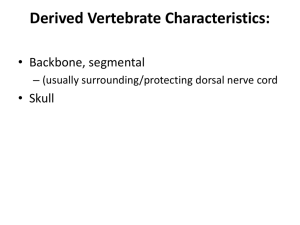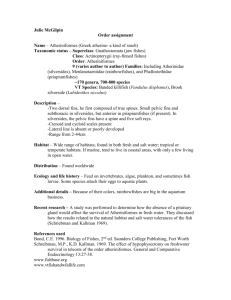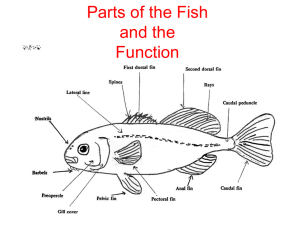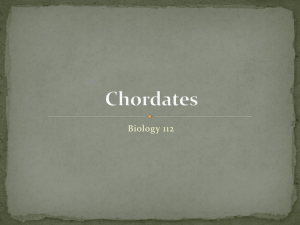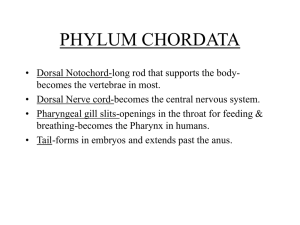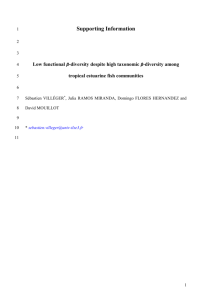Lobed-Finned Fishes
advertisement
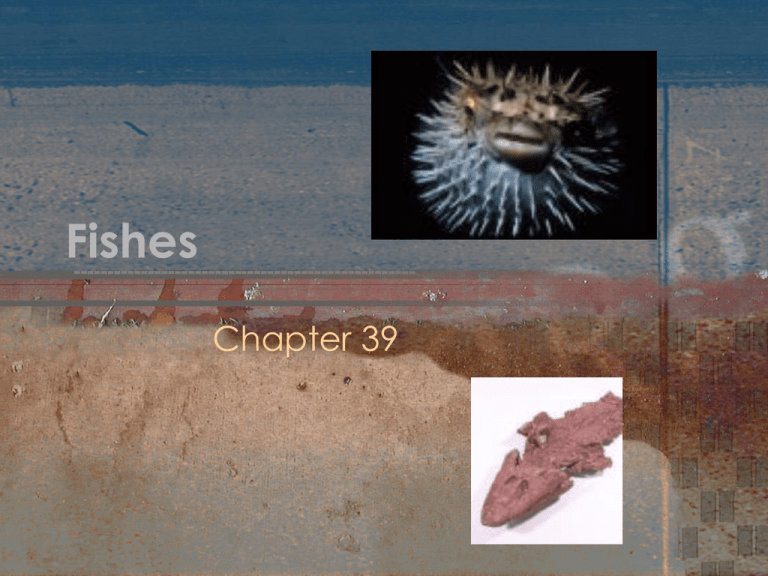
Fishes Chapter 39 Introduction to Vertebrates Section 39.1 Vertebrate Characteristics • Only 1 phylum: Chordata • Three distinguishing characteristics: 1. Vertebrae: bones or cartilage that surrounds and protects dorsal nerve cord (spine) 2. Cranium: skull that protects the brain 3. Endoskeleton composed of bone or cartilage Vertebrate Classification • Nine Classes: 1. Hagfishes: elongated, eel-like bodies, lack jaws, no paired fins, no vertebrae (have notochord) 2. Lamprey: same as hagfish except they have a primitive vertebrae 3. Sharks, Rays, & Skates: jaws, paired fins, cartilage skeleton 4. Ray-finned Fish: jaws, bony skeleton, Classification Continued 5. Lobed-finned Fish: fins on main axis of body 6. Amphibians: thin & permeable skin, eggs & larval stage in water 7. Reptiles: dry & scaly skin, eggs on land 8. Birds: flight, feathers, hollow bones, unique respiratory system 9. Mammals: hair, mammary glands Vertebrate Evolution • 560 million years ago • First vertebrae = tadpole like, jawless fish Origin of Jaws • 450 million years ago • Evolved from first pair of gill arches: – skeletal elements that protect pharynx • Jaws aid in food seizure and manipulation Scientific Names: • Hagfish – Class Myxini • Lamprey – Class Cephalaspidomorphi • Sharks, Rays & Skates – Class Chondrichthyes • Ray-Finned Fish – Class Actinopterygii • Lobed-Finned Fish – Class Sarcopterygii • Amphibians – Class Amphibia • Reptiles – Class Reptilia • Birds – Class Aves • Mammals – Class Mammalia Jawless & Cartilaginous Fishes Section 39.2 Characteristics for the Water: • Streamline body shape • Strong muscular tail for propulsion • Paired fins to maneuver in multiple directions • Secreted mucus to reduce friction • Stored fat to help float • Gills for respiration Homeostasis • Maintain homeostasis through osmosis – osmoregulation • Waste removal organs: kidneys & gills – Kidneys filter wastes from blood & removes excess water as urine • Out through the cloaca – Gills remove waste gases (CO2) and excess ions directly into the water Sensory functions • Advanced senses to detect light, chemicals, sound, electrical and magnetic fields – Chemoreception: detect chemicals in the form of smell and taste • Lateral line system: – Row of sensory structures that run the length of the fish’s body on each side – Connected by nerves to the brain – Detects vibrations in water Jawless Fishes • Hagfish (Class Myxini): – Bottom dwellers, marine habitat – No vertebrae (have notochord) – Mouth with two movable plates & rough tongue-like structure • Burrow into body eat from the inside out • Lamprey (Class Cephalaspidomorphi) : – Some are parasitic on other fish – Disk-shaped mouth with rough tongue that scrapes a hole into host Cartilaginous Fishes • Class Chondrichthyes • Examples: Sharks, rays, & skates • Skeletons made of cartilage: – Flexible, lightweight material made of cells surrounded by tough fibers of protein • Carnivores • Skin covered with placoid scales: – Small, tooth-like spines that feel like sandpaper Adaptations • Gills for respiration – Fast swimming or pumping water over gills – Rays & skates have spiracles to draw in water • Rectal gland: end of intestine that removes excess ions from the blood and releases into rectum for elimination • LARGE liver stores lipids to maintain buoyancy Reproduction • Internal fertilization • Male inject sperm into female with modified pelvic fins called claspers • Many cartilage fish have live birth • No parental care once born Rays & Skates • • • • Flattened bodies Wing-like pectoral fins Bottom dwellers Most feed on mollusks and crustaceans Sharks • Pectoral fins: just behind head, jut out from body like wings of a plane • 20,000 teeth during lifetime! – Multiple rows • Olfactory bulbs: part of brain that detect smells from paired nostrils • Fusiform: smooth, torpedo-shaped bodies that reduce turbulence Abdominal Cavity Digestive Tract Liver Reproductive Organs Dissection video Bony Fishes Section 39.3 Characteristics • Bone: harder & heavier than cartilage • Lungs or swim bladder: early fish have lungs, most have a swim bladder (gas filled sac used to control buoyancy) • Scales: protect fish & reduce water resistance Lobed-Finned Fishes • Fleshy fins • Example: lungfish – Breath through lungs and gills – Live in shallow tropical ponds – Ancestors of amphibians & other terrestrial vertebrates Ray-Finned Fish • Rays: long, segmented, flexible bony elements that support the fins – Evolved from scales • Diverse in appearance, behavior, & habitat • Familiar fish External Anatomy • Distinct head, trunk, & tail regions • Operculum: hard plate that opens toward the rear and covers & protects gills • Caudal fin: extends from tail & moves side to side • Dorsal fins: anterior & posterior • Pelvic fins & pectoral fins: help navigate fish • Scales: skin of fish that grow quickly when food is abundant – Growth rings Dorsal Fin Caudal Fin Operculum Pectoral Fin Pelvic Fin Anal Fin Internal Anatomy • Skeleton = skull, spinal column, pectoral girdle, pelvic girdle, & rib • Pectoral girdle: where pectoral fins attach – shoulders • Pelvic girdle: where pelvic fins attach – hips Digestive System • Generalized carnivores • Predatory fish have jaws lined with inward pointing teeth • Path of food: – Mouth pharynx (throat cavity) esophagus stomach + enzymes intestines (absorption of nutrients) + gallbladder that excretes bile (breaks down fats) from liver + pancreas’ enzymes anus Circulatory System • Delivers oxygen & nutrients and removes waste carbon dioxide & ammonia • Consists of heart, blood vessels like capillaries, veins, & arteries The Heart • Two chambers in a row • Sinus venosus: deoxygenated blood empties into this collection area 1. Atrium: contractions move blood to the ventricle 2. Ventricle: main pumping chamber • Conus arteriosus: valves to prevent backflow of blood Respiratory System • Water goes into mouth, past gill filaments and out the operculum • Blood flows in a countercurrent flow opposite of water flow – Allows for more O2 diffusion Excretory System • Kidneys: dissolve chemical wastes from blood resulting in urine (with ammonia) • Urinary bladder: holds urine until expelled Swim Bladder • Thin walled sac in abdominal cavity • Contains a mixture of O2, CO2, and N2 • Enables movement up and down Nervous System • Contains brain, spinal cord, nerves, & sensory organs • Most sensory organs connected to brain via cranial nerves The brain • Olfactory bulb: processes info of smell • Cerebrum: integrates information for other areas of the brain • Optic tectum: processes info of sight • Cerebellum: coordinates motor output • Medulla oblongata: controls body functions Reproduction • Spawning: reproductive behavior of fish • Eggs & sperm released into water through opening behind anus • Most fish use external fertilization Fish Dissection Close-up: Body Cavity Ovary Muscle Swim Bladder Eggs Liver Gastric Cecae Spleen Small Intestine Stomach Anterior View 1. Gills 2. Heart 3. Liver 4. Pyloric caeca 5. Small intestine 6. Stomach 7. Swim bladder Posterior View 1. Swim bladder 2. Gonad 3. Large intestine 4. Urinary bladder 5. Anus

